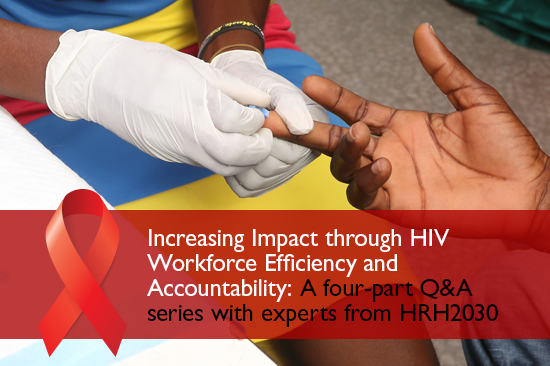
08 Dec AIDS Day Q&A Part 4: Making the Case for Investing in HRH
 Catherine Barker, a senior associate with HRH2030 partner Palladium, specializes in health economics. Over the last four years, Catherine has provided technical assistance to ministries of health and civil society organizations in Africa and Asia to inform health systems strengthening initiatives, particularly related to health financing and human resources for health.
Catherine Barker, a senior associate with HRH2030 partner Palladium, specializes in health economics. Over the last four years, Catherine has provided technical assistance to ministries of health and civil society organizations in Africa and Asia to inform health systems strengthening initiatives, particularly related to health financing and human resources for health.
Why is there a need in high HIV burden countries, like Uganda, to develop HRH investment cases for HIV service delivery?
Globally we need to share financial responsibility for controlling the HIV/AIDS epidemic, and this includes sufficient and efficient use of funding for the health workforce delivering HIV services. However, in many high-burden countries, there is a shortage of funding or inefficient processes to recruit, train, support, and retain these health workers. HRH investment cases can be developed to convince the government to make more strategic investments in HRH for HIV, including increasing funding for HRH (e.g., absorbing donor-supported health workers – both facility and community-based); improving efficiency in spending (e.g., balancing investment in pre-service education vs. in-service training); making more efficient use of existing staff; and improving use of the health workforce as a whole (e.g. rationalized HRH allocation, skill mix composition, and implementation of differentiated models of care). HRH investment cases are supported by evidence and typically include a description of the various potential HRH investment scenarios, their respective efficiency gains, and why they are needed, including estimates of the potential impact of these investments on health outcomes and economic growth. Having an HRH investment case allows stakeholders and advocates to rally behind a single message and funding ask of the Ministry of Finance.
How is HRH2030 equipping health advocates with the information or evidence they need to inform more strategic investments and efficiencies in HRH for HIV?
HRH2030 provides technical assistance in generating evidence for making smarter and more efficient HRH investments. As an example, HRH2030 estimated the costs, fiscal space, and political economy of HRH investment for HIV in Uganda. The analyses demonstrated that Uganda needs to make additional investments in the HIV workforce and improve efficiency in HIV service delivery to reach its HIV targets. Notably, the analyses found that scaling-up differentiated care models for HIV treatment, where stable patients spend less time with facility-based health workers compared with previous service delivery models, could improve HRH efficiencies and reduce the HRH for HIV funding gap by 60 percent in 2020. The remaining gap must be filled by additional investments in the health workforce. This evidence can be used by the Ministry of Health, civil society, parliament members, and other stakeholders and advocates to mobilize the domestic resources required, and to make more strategic and efficient use of their health workforce, to reach the country’s HIV goals.
How will stronger national investment in HRH ensure long-term sustainability of programs working to control the HIV/AIDS epidemic?
Strategic investment in HRH may require increased spending, reallocation of existing financial resources, and/or smarter use of HRH through differentiated models of care and streamlining of services to gain more efficiencies. Strategic government investment in HRH is particularly critical in countries facing transitions in donor funding. For many years, PEPFAR and other donors have made significant investments in countries’ health workforce to fill acute shortages as countries scaled-up access to HIV services, with the expectation that this funding would transition from external to domestic sources over time. As countries, like Uganda, are now in the process of sustainability planning, they need to increase spending on HRH while making more efficient use of existing funds and workforce to maintain current coverage of HIV services. Strategic national investment in HRH will support a country’s efforts to maintain a sufficiently-skilled and motivated workforce that is willing and able to provide high-quality HIV services over time.
Others in this Series
Part 1: Increasing HIV Impact through Human Resources for Health Interventions
Part 2: Optimizing the Role of Community-Based Workers in HIV Service Delivery
Part 3: Standardized Use of Site-Level HRH Data for Differentiated Models of ART Delivery
Part 4: Making the Case for Investing in HRH





